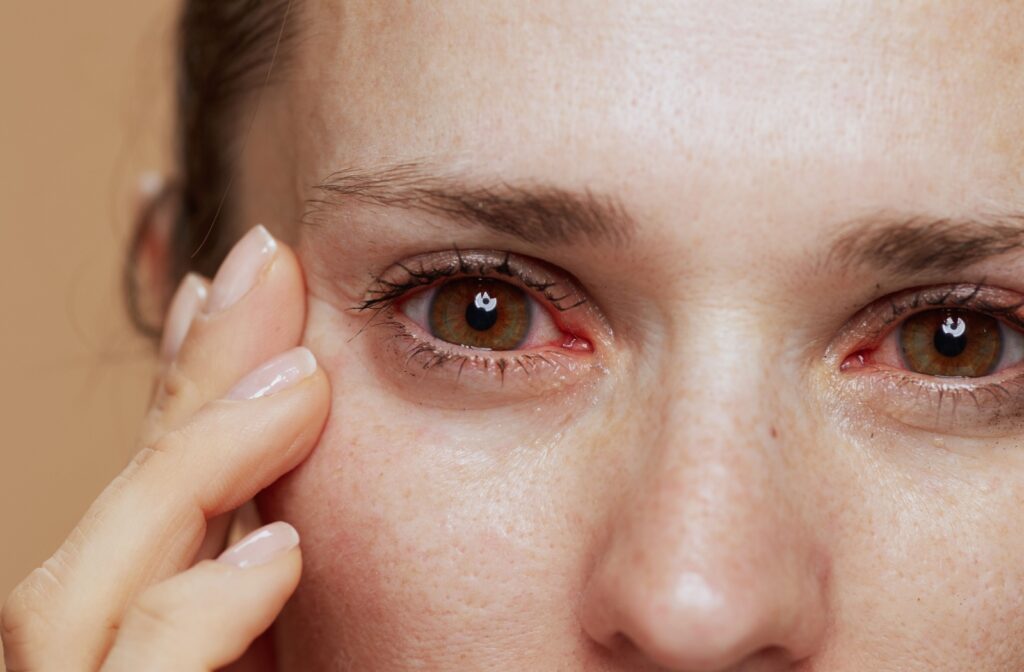Most people think of dry eyes as a minor inconvenience. A bit of irritation, redness, and blurry vision may not feel so terrible, but leaving this condition unmanaged can lead to problems.
Dry eyes alone don’t directly lead to vision loss. Rather, vision loss can occur because of complications associated with unmanaged dry eyes.
Persistent dryness damages and irritates the corneal surface. Over time, this can lead to complications like corneal ulcers, abrasions, and infections, which, if left unmanaged, can lead to partial or complete vision loss.
Defining Dry Eye
Dry eye disease, a chronic and common condition, occurs when the tear film is imbalanced, leading to insufficient lubrication on the eye’s corneal surface.
A dry, gritty sensation is a hallmark of this condition, which causes discomfort, and irritation, and affects your ability to see clearly. It’s more than just a minor inconvenience. Persistent dryness can seriously impair one’s quality of life.
Tears are more than just water. They’re a complex mixture of water, oils, and mucin, working together to protect and lubricate the eyes. This mixture forms what’s known as the “tear film”.
An imbalance in any component of the tear film leads to dry eyes.
There are two main types of dry eyes:
- Aqueous deficiency dry eye: This occurs when the tear film can’t produce enough tear fluid to keep the eye lubricated.
- Evaporative dry eye: This occurs when your eyes don’t retain moisture, often because of insufficient oil in your tears. This causes tears to evaporate quickly from the eyes’ surface.
Symptoms can range from mild to severe and can include:
- Redness
- Blurry vision
- Watery eyes
- Sensitivity to light
- Burning, itching, or stinging sensations
- A heavy or tired sensation in the eyes
Several factors can lead to an imbalance in the tear film, causing dry eyes, including:
- Age: Tear production declines naturally as we grow older.
- Environmental conditions: Wind, smoke, and dry air can accelerate tear evaporation.
- Prolonged screen time: Focusing on digital screens reduces blinking frequency, leading to faster evaporation and insufficient tear distribution.
- Meibomian gland dysfunction (MGD): Meibomian glands are found along the eyelids and secrete oils that prevent tear evaporation from the eye’s surface. Dysfunction in these glands leads to quicker evaporation. MGD is one of the most common causes of evaporative dry eye.
How Dry Eye Affects Vision
Although dry eyes might seem like a minor issue, it may surprise some to learn the connection between this condition and visual clarity.
A properly functioning tear film maintains a smooth corneal surface. When light passes through a smooth cornea, it can focus directly on the retina, allowing for clear vision.
Disruptions in the tear film compromise corneal smoothness. When light passes through an uneven cornea, it scatters instead of properly focusing on the retina. This scattering leads to blurry or fluctuating vision.
The more unstable the tear film, the greater the likelihood of fluctuating and unclear vision.
Fluctuating vision may appear more aggressive at night, making it more difficult for those with dry eyes to adapt to low-light conditions and increased glare and halos around lights.

Can Dry Eye Cause Vision Loss?
Experiencing persistent dryness doesn’t mean vision loss is inevitable.
Dry eyes itself don’t directly cause vision loss. When the condition remains unmanaged, the associated complications can lead to vision impairment.
As dryness persists, the corneal surface becomes inflamed and irritated, which can lead to irregularities. Over time, this may damage the cornea through thinning or scarring, increasing the risk of corneal ulcers, abrasions, or infections.
If these complications remain unmanaged, it can lead to partial or complete vision loss.
Therefore, while rare, the consequences of unmanaged dry eye emphasize the need for timely intervention and management to preserve vision.
Managing Dry Eye
While dry eye currently can’t be cured because of its chronic nature, it’s highly manageable. Treatments range from at-home remedies to advanced therapies aiming to offer long-term relief from dry eye symptoms.
A dry eye consultation is central to finding a management strategy suitable for a patient’s unique concerns. This visit allows your optometrist to identify the severity of dryness, the status of the tear film, and vision quality, to develop a tailored therapy plan.
Our clinic offers a few advanced therapy options for long-term dry eye relief:
- Xiidra and Restasis: These prescription eye drops improve tear production by reducing inflammation in the tear-producing glands.
- Punctal Plugs: These tiny devices are inserted into the tear ducts to stop tears from draining too quickly, keeping your eyes hydrated.
These at-home remedies can be used alongside advanced therapies to help maintain results from the treatments:
- Artificial tears: These over-the-counter drops offer immediate relief from dry eye symptoms by mimicking the natural production of tears. Opt for preservative-free options if you plan on using them frequently.
- Blink breaks: Practicing the 20-20-20 rule can help combat digital eye strain. Take a 20-second break every 20 minutes to look at something 20 feet away.
- Eye ointments: This is applied along the lash line before bed, helping to keep your eyes lubricated overnight. Because this ointment can temporarily blur your vision, they are best used at night.
- Humidifiers: Add moisture to dry indoor spaces to help prevent tear evaporation.
- Hydration: Drink plenty of water to maintain overall hydration, which supports tear production.
- Warm compresses: A warm compress over your eyes can stimulate oil production in the meibomian glands, improving tear quality.
Schedule a Visit
While it’s tempting to dismiss dry eye as a minor irritation, it’s much more serious than it seems.
Without management, this condition can lead to chronic discomfort, corneal damage, and, in rare cases, significant vision loss.Connect with our team at Advanced Eye Care Center to schedule a visit for a dry eye consult.





